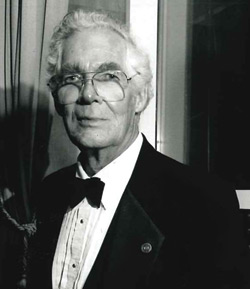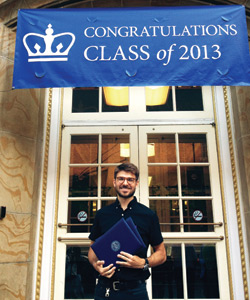Alumni Profile: Donald Lindberg’58, Christian Rose’13
Medical Informatics Leader
 Donald Lindberg’58
Donald Lindberg’58Christian Rose’13, recipient of the inaugural Donald A.B. Lindberg Award for Excellence in Biomedical Informatics, given at graduation, has always enjoyed pondering the future.
“I was always thinking about space travel and airplanes and cars and submarines,” he says. “But, somewhere deep inside me, I have always loved helping people. The idea of being a physician has always been there.”
So it was natural that he sought a career that combines the scientist’s fascination with technology with the qualities of empathy and care that define the practice of medicine. After graduating from Vassar College in 2007, Dr. Rose entered the class of 2013 at P&S. He was immediately drawn to biomedical informatics, a relatively young, interdisciplinary field at the nexus of health care, biology, clinical informatics, and computer and information sciences.
Much of the groundwork for biomedical informatics was laid by Donald Lindberg’58, the inventor of the first computer-based laboratory system and author of three books and more than 200 articles and reports. In a professional career now in its fifth decade, he has pioneered the use of computers in medicine, first as a faculty member and director of the Diagnostic Microbiology Laboratory at the University of Missouri and later as director of the National Library of Medicine, the world’s most extensive biomedical library.
The invention of the computer-based laboratory system in the early 60s was, like many innovations, the product of necessity. Until then, medical records were handwritten, which meant “misspellings, late reporting, and occasionally inadvertent errors,” says Dr. Lindberg. “I was a newcomer to computing, but it was immediately obvious that important quality control measures—especially in the clinical chemistry lab—could be automatically implemented by the computer system.” This eventually led to what is now known as the electronic patient record.
Soon thereafter, Dr. Lindberg, with the help of a physics graduate student, developed a computer capable of running mathematical models of bacterial growth. This led to a revelation, ending “a period of great anxiety,” says Dr. Lindberg. “I was torn between my duties supervising the clinical labs of the hospital and my duties conducting research in my NIH-supported research lab. One day in 1960, it dawned on me that computer-based information systems spelled the answer in both cases.”
For his work, Dr. Lindberg has been lauded as one of the world’s preeminent authorities on medical informatics. He is a member of the Institute of Medicine of the National Academy of Sciences. He was awarded the Surgeon General’s Medallion of the U.S. Public Health Service, among other honors, and appointed by President George H.W. Bush to the post of director of the National Coordination Office for High Performance Computing and Communications.
Under his stewardship, the National Library of Medicine was transformed into a cutting-edge repository for medical information. Numerous important changes over the past three decades include Medline, the largest collection of medical information in the world, and the Unified Medical Language System, an electronic thesaurus of medical terminology. The library was instrumental in the Human Genome Project, organizing, storing, and preserving the immense amount of data the project produced.
These innovations have transformed the practice of medicine—and science in general. Modern genetics and genomics simply could not exist without scientific computing systems.
At P&S, biomedical informatics researchers work in areas as diverse as computer simulations of biological systems, electronic health records, telemedicine, natural language processing, data mining, machine learning, and intelligent systems. Today, physicians use computers to diagnose illness, make treatment decisions, and monitor drug interactions.
“Technology is no longer just a tool that some clinicians use,” says Dr. Rose. “With electronic health records and big data projects, medical technologies are part and parcel of the practice of medicine, and informatics is at the core.”
Though omnipresent, biomedical informatics is poorly understood by the general public. “We’ve had a branding problem,” says Herbert Chase, MD, professor of clinical medicine (in biomedical informatics). “People didn’t know what we do. How do you get students and faculty interested in a new discipline?”
To address this issue, the Department of Biomedical Informatics created the Lindberg Award, which simultaneously honors Dr. Lindberg, recognizes innovators of the future, and raises awareness for the discipline. Robert Sideli, MD, associate professor of biomedical informatics and CUMC chief information officer, chaired the award’s selection committee.
Dr. Rose received the award in part for his imagination and zeal in promoting biomedical informatics. In 2009, with the help of a few fellow tech enthusiasts, he founded the Innovative Medicine Interest Group, with the sponsorship of Department of Biomedical Informatics professors Dr. Chase and George Hripcsak’85. The focus, Dr. Rose says, was “not the medicine that has become regular practice but the medicine that will become regular practice.” In April 2013, the group hosted a TEDMED conference, which featured presentations by eight Columbia University faculty members and the live streaming of talks given at the national TEDMED conference in Washington, D.C.
“I knew that people were interested,” Dr. Rose says, “but it’s amazing how it grew. In only a few short years, we went from one to five to 20 students doing research and presenting at conferences in informatics.”
After graduating in May 2013, Dr. Rose started a residency at the University of California, San Francisco, where he is applying his knowledge of informatics to the emergency room, “an area of medicine that’s like the wild west.”
 Christian Rose’13
Christian Rose’13“In terms of its need for up-to-the-minute information, the emergency room is king. We need to be able to visualize a patient’s health status, past conditions, and current trajectory in only a few minutes.” By devising new ways of interpreting data, as well as refining currently existing technologies such as alerting systems, medical records, and interaction checking, Dr. Rose hopes to streamline the way emergency physicians work.
Popular culture abounds with depictions of dystopian futures where emotionless robots rule the world with exacting efficiency. “Students always ask me, ‘Is Watson going to take my job?’” Dr. Chase says, referring to the supercomputer contestant on “Jeopardy!” who in 2011 trounced former champions Ken Jennings and Brad Rutter.
A computer can do many things better than we can, says Dr. Chase. It can screen for drug interactions; it can summarize the boundless data of a patient’s medical history, prioritizing to ensure that what’s most important is seen by the doctor; it can overcome human biases. By incorporating what the computer offers, doctors can better diagnose illnesses and predict the effectiveness of treatments.
The swift advances in computer technology, says Dr. Chase, will lead to a re-evaluation of the role of the physician. The doctor of the future will function more as an intermediary between computers and patients, synthesizing the information provided by machines and tailoring it to the needs of the individual patient.
“The next big thing in medical informatics, to me, will be engaging the patient in a sensible way,” says Dr. Rose. “No longer does the power of diagnosis and treatment lie solely in the hands of the physician. Helping patients to become advocates for their own health in their daily life is something that I think will change the face of medicine—and it’s within our power to bring this about.”
Biomedical informatics frees the individual physician from the burden of being expected to know everything so physicians can return to ‘what we did well a hundred years ago: caring for patients.’
Paradoxically, this brave new world harkens to the profession’s past. “A hundred years ago, we spent a lot of time comforting people,” Dr. Chase says. Treatment was often a shot in the dark; doctors knew that certain methods and medicines worked, but not why. In the 20th century, the application of the scientific method to medicine radically changed the physician’s role: Physicians became expected to be encyclopedias of ailments and treatments, abreast of all the latest discoveries. Gradually, the interpersonal dimension of medicine—the caregiving—became less important, as patients demanded diagnoses and cures.
Biomedical informatics, by pooling the collective expertise and wisdom of the medical community, frees the individual physician from the burden of being expected to know everything. Physicians can return to “what we did well a hundred years ago: caring for patients.”
So though Watson may be able to read 65 million pages per second, aspiring physicians need not fret about being replaced by robots. “Artificial intelligence will never take the place of doctors,” says Dr. Chase. “What Watson can do is very narrow—it can read and make correlations. But it doesn’t have the ability to get inside a patient’s mind. The physician’s primary role is to care for patients. As we know, medicine is both a science and an art.”
Dr. Rose agrees: “Being a physician is so much more than just making a diagnosis or knowing drug interactions—it’s caring, treating, and empathizing. Computers are only as good as the data put into them. At the end of the day, we are the ones who work with the patients and help them get where they want to go.”
- Log in to post comments

